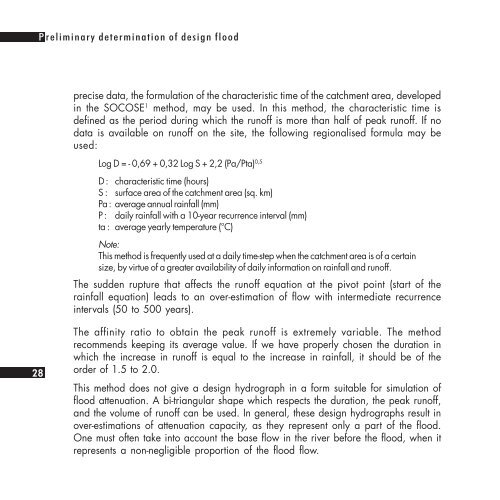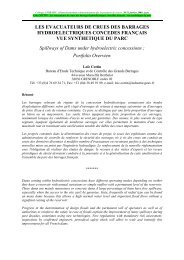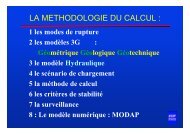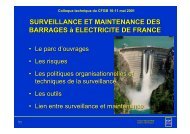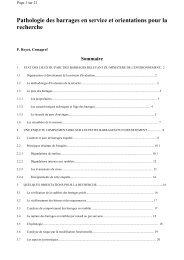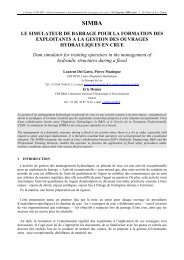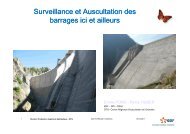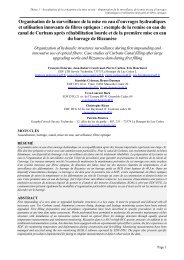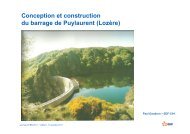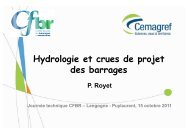SMALL DAMS
SMALL DAMS - Comité Français des Barrages et Réservoirs
SMALL DAMS - Comité Français des Barrages et Réservoirs
- No tags were found...
Create successful ePaper yourself
Turn your PDF publications into a flip-book with our unique Google optimized e-Paper software.
P reliminary determination of design flood<br />
precise data, the formulation of the characteristic time of the catchment area, developed<br />
in the SOCOSE 1 method, may be used. In this method, the characteristic time is<br />
defined as the period during which the runoff is more than half of peak runoff. If no<br />
data is available on runoff on the site, the following regionalised formula may be<br />
used:<br />
Log D = - 0,69 + 0,32 Log S + 2,2 (Pa/Pta) 0,5<br />
D : characteristic time (hours)<br />
S : surface area of the catchment area (sq. km)<br />
Pa : average annual rainfall (mm)<br />
P : daily rainfall with a 10-year recurrence interval (mm)<br />
ta : average yearly temperature (°C)<br />
Note:<br />
This method is frequently used at a daily time-step when the catchment area is of a certain<br />
size, by virtue of a greater availability of daily information on rainfall and runoff.<br />
The sudden rupture that affects the runoff equation at the pivot point (start of the<br />
rainfall equation) leads to an over-estimation of flow with intermediate recurrence<br />
intervals (50 to 500 years).<br />
28<br />
The affinity ratio to obtain the peak runoff is extremely variable. The method<br />
recommends keeping its average value. If we have properly chosen the duration in<br />
which the increase in runoff is equal to the increase in rainfall, it should be of the<br />
order of 1.5 to 2.0.<br />
This method does not give a design hydrograph in a form suitable for simulation of<br />
flood attenuation. A bi-triangular shape which respects the duration, the peak runoff,<br />
and the volume of runoff can be used. In general, these design hydrographs result in<br />
over-estimations of attenuation capacity, as they represent only a part of the flood.<br />
One must often take into account the base flow in the river before the flood, when it<br />
represents a non-negligible proportion of the flood flow.<br />
THE AGREGEE MODEL 2<br />
A recent development by Cemagref 3 , this model is an extension to the GRADEX<br />
method. Re-using its statistical concepts and the hypothesis that when the catchment<br />
area is saturated, any increase in rainfall generates an equal increase in runoff. The<br />
modifications are based on:<br />
!"combining the laws of probability of rainfall and runoff to progressively go from the<br />
runoff equation to the rainfall equation;<br />
1. See Bibliography, references 1 and 12, p. 36.<br />
2. See Bibliography, reference 9, p. 36.<br />
3. Cemagref : The french agricultural and environmental research institute – http://www.cemagref.fr


